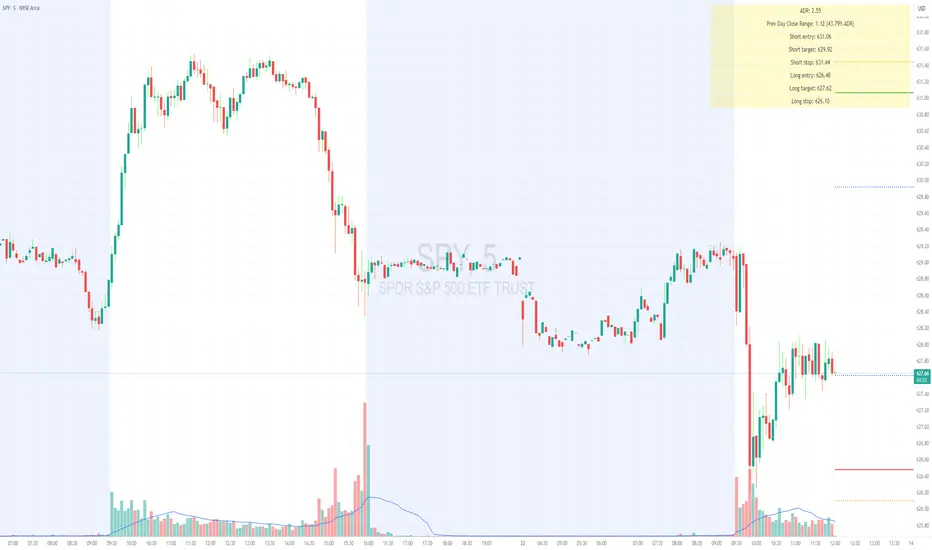OPEN-SOURCE SCRIPT
Updated ADR Table

Track volatility and session momentum in real-time with customizable precision.
Key Features:
Average Daily Range (ADR): Configurable length (default 5 days), based on previous daily high–low ranges.
How to Use
Why It Matters
Quickly assess where price stands relative to typical volatility.
Easily identify intraday price exhaustion or breakout zones.
Anchor flexibility enables use for both futures and equities, aligning with your trading session.
Clean, professional display—no clutter, no guesswork.
Key Features:
Average Daily Range (ADR): Configurable length (default 5 days), based on previous daily high–low ranges.
- Session Anchor Options: Choose anchor at 4 am NY, 6 pm NY, 9:30 am NY, 8:30 am NY, Previous Day Close, or Current Bar.
- Session Range & %ADR: Displays the real-time range from the chosen anchor, plus what percentage of ADR has been covered.
- High / Low Target Levels: Calculates ADR targets based on anchor: anchor ± ADR.
- Optional Target Lines: Draw horizontal lines for high and low targets across the session; customize color and width.
- Dynamic Table Display: User-selectable table size and text size (Tiny to Huge) for optimal readability.
- Robust Anchor Logic: Uses the first bar at-or-after anchor time each NY day, ensuring stability even on irregular intraday timeframes.
How to Use
- Choose your anchor in settings.
- View ADR, session range (with %ADR), and target price levels in the top-right pane.Toggle High/Low lines to overlay targets on the chart.
- Adjust table and text size to match your workspace.
Why It Matters
Quickly assess where price stands relative to typical volatility.
Easily identify intraday price exhaustion or breakout zones.
Anchor flexibility enables use for both futures and equities, aligning with your trading session.
Clean, professional display—no clutter, no guesswork.
Release Notes
ADR Table + Mean Reversion LevelsOverview:
This indicator overlays a fully configurable Average Daily Range (ADR) table and mean reversion trade levels on your chart. Designed for traders who use the ADR as a volatility anchor for intraday reversion setups, it provides a visual workflow for both discretionary and systematic strategies.
Features:
- ADR Table: Shows current ADR, session anchor range, long/short entry levels, profit targets, and stop-losses—all auto-calculated and color-coded.
- Anchor Options: Choose from multiple session opens (4am NY, 6pm NY, 9:30am NY, 8:30am NY, previous day close, or current bar) for flexible backtesting and live trading.
- Customizable Levels: Set entry, target, and stop as a percentage of ADR; instantly adapts to your risk and style.
- Table View Selector: Focus only on long or short setups, or show both sides—perfect for directional bias or two-way trading.
- Chart Lines: Entry, target, and stop levels are drawn on the chart for easy reference and alerts.
- Dynamic Updates: All levels and the table update in real-time as the session evolves.
Use Cases:
- Intraday and swing mean reversion trading (ES, NQ, CL, GC, FX, equities, etc.)
- Quickly spot where price is relative to ADR extremes and mean-reversion levels
- Filter setups by session or regime using the anchor and table-side selector
- Use as a standalone playbook or as a visual aid for systematic signal development
How To Use:
- Select your preferred ADR length, anchor, and trade parameters in the settings.
- Choose which side to display in the table (“Long”, “Short”, or “Both”).
- Use the plotted lines and table to identify key mean reversion levels for execution, stops, and targets.
- Combine with price action, tape, or flow data for confirmation.
Tip:
Adjust your settings for instrument volatility and session. For ES futures, 5-10 day ADR and the 4am NY anchor are common for both premarket and RTH studies.
Open-source script
In true TradingView spirit, the creator of this script has made it open-source, so that traders can review and verify its functionality. Kudos to the author! While you can use it for free, remember that republishing the code is subject to our House Rules.
Disclaimer
The information and publications are not meant to be, and do not constitute, financial, investment, trading, or other types of advice or recommendations supplied or endorsed by TradingView. Read more in the Terms of Use.
Open-source script
In true TradingView spirit, the creator of this script has made it open-source, so that traders can review and verify its functionality. Kudos to the author! While you can use it for free, remember that republishing the code is subject to our House Rules.
Disclaimer
The information and publications are not meant to be, and do not constitute, financial, investment, trading, or other types of advice or recommendations supplied or endorsed by TradingView. Read more in the Terms of Use.